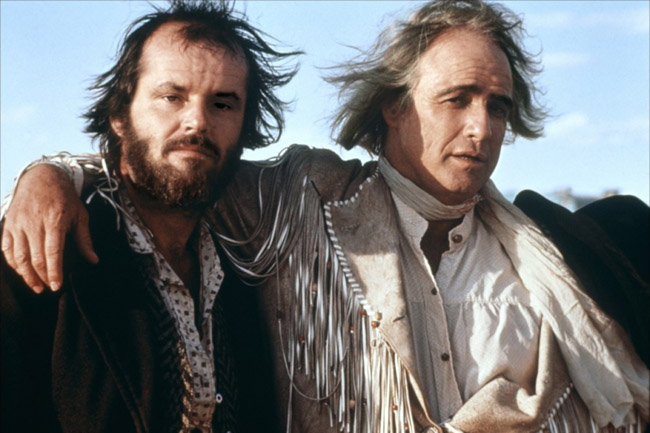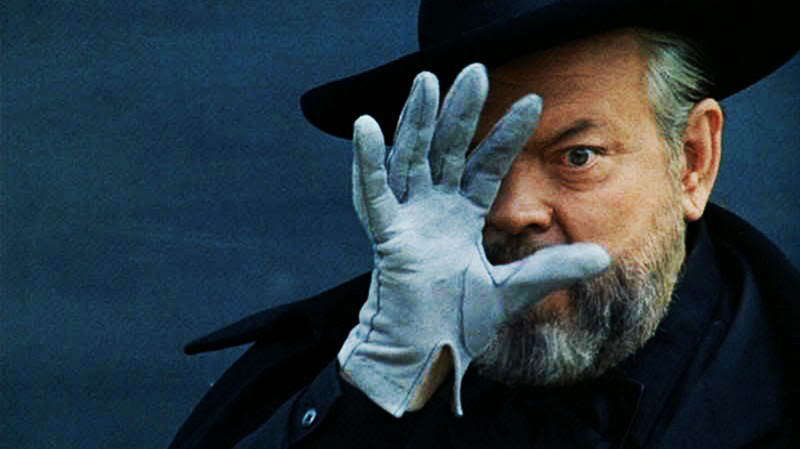6. The Missouri Breaks (1976)

The Missouri Breaks is one of those films where the making of it has become better known than the actual film itself; which in this case, is a shame, for Arthur Penn’s demented western is certainly one of the best examples of the genre’s renaissance in the sixties and seventies.
Nicholson plays Tom Logan, a rustler who, with his gang of grotty sidekicks, robs a train, only to lose most of the money straight afterwards. They move closer to the ranch of their rival, Braxton, and start to rustle his stock. While his gang go off on their unsavoury adventures, Logan falls for Braxton’s daughter, much to her old man’s horror. Pushed to the edge, Braxton hires Robert E. Lee Clayton, who he pays to take care of the pesky rustlers. Marlon Brando plays Clayton in one of the wildest and most entertaining performances you will ever see, and the film results in a showdown between Logan and Clayton, the former then wishing to get revenge on Braxton himself.
Missouri Breaks is the kind of film that looks fairly standard on paper, but is actually totally eccentric on the screen. It is, of course, all down to Brando’s efforts, which are so feral that, though great to watch, they could have easily destroyed the whole picture. For Nicholson, acting with his teen idol was a dream come true, but as soon as Brando started to misbehave, he felt rather embarrassed. He refused to read his lines as the script told, and totally reshaped his character. A completely over the top piece of acting, Brando makes Jack look tame.
The Missouri Breaks was highly hyped at the time, featuring two generations of acting idols, both of whom were recent Oscar winners – Jack with Cuckoo’s Nest, Brando with The Godfather. But the film was a financial flop and critics pounced on it. That said, now it’s nearly fifty years old the film can be enjoyed on its own terms. The supporting cast of quirky bit players are splendid, in particular Randy Quaid and Harry Dean Stanton, while no true film fan could not enjoy the last third of the picture, and the anticipated showdown between the two screen giants.
7. The Traveling Executioner (1970)

One of the true hidden gems of early seventies American cinema is The Traveling Executioner, a truly dark but strangely comedic character film that casts Stacy Keach centre stage as Jonas Candide, an ex carnival showman who’s started a new, rather unconventional career.
The year is 1918, and Jonas travels the south of the United States with his portable electric chair, which he brings to any prison willing to pay him 100 dollars for his services. Before the real plot starts to unravel, we are introduced to Jonas’s unconventional but entertaining methods of executing killers and rapists. Though the tone is contradictorily morbidly light in the opening chapters, things soon become complicated when Jonas falls for Gundred (Marianna Hill), a woman he has been hired to execute.
The film, written by Garnie Bateson, is a real one off, and it’s fair to say you will never see another movie quite like this one. Directed smoothly by Jack Smight, the acting is note perfect. Among the supporting cast stand outs are Bud Cort, and the always excellent M. Emmet Walsh as the Warden of the prison. But it is Keach’s show through and through, delivering a spellbinding performance that is so multi-layered you wonder how he managed to pull such a feat off in one 90 minute movie. Captivating when he’s performing for each execution, he is every bit the mad eyed master of ceremonies. As the film goes on though, this bold, confident executioner begins to unravel.
Unfortunately The Traveling Executioner was not a hit upon release, perhaps too dark for a comedic audience and just too damn baffling for any other. Retrospectively however, it’s an excellent film, superbly played, and one of those bizarre films that has to be seen to be believed. Not the most readily available film, you can get it on region 1 DVD and also an old PAL VHS in the UK.
8. Bear Island (1979)

Based on Alistair MacLean’s hit novel, 1979’s Bear Island is an engaging and entertaining thriller that these days seems to be stuck in a black hole of film distribution. In other words, you can’t get a hold of it unless you want to part with a week’s wages.
The film begins when Larsen, a scientist, sends out a signal of distress using an emergency frequency. A vessel named Morning Rose receives his signal, but the man dies before he can send anything remotely meaningful. On board the Morning Rose are various UN scientists, and they are joined by American biologist Lansing (Donald Sutherland). who immediately mistrusts those on the boat. When they reach the Norwegian Bear Island they try to access the U-boat base, but they are blocked from doing so. Complications mount, with Lansing’s message revealing sinister details about some of the scientist’s true identities, and much interest being focused on a U-boat full of gold.
Directed and co-written by Don Sharp, Bear Island is a straight forward good old fashioned thriller, highly engaging and full of satisfying twists and revelations. The cast are all splendid too, actors of the highest calibre staying true to the script and relenting from providing over the top theatrics. Sutherland leads the cast, but there are also solid supporting efforts from Vanessa Redgrave, Lloyd Bridges, and Christopher Lee.
Bear Island was a modest hit upon release, though Sharp later revealed it made most of its money on home video. It’s another los tgem that needs re-releasing.
9. F For Fake (1973)

F For Fake is Orson Welles’ film essay on the great forger Elmyr de Hory, but of course, in true Welles style, it is also much more than that. One half of the film is pure documentary, while the other half redefined what it was to make a study of an individual and his chosen profession, in this case a famous fake. Putting in scenes of his exotic looking girlfriend Oja Kodar, himself, and the great famed hoax writer Clifford Irving, while also delving into Howard Hughes, the War of the Worlds radio broadcast, and the art of the hoax, F For Fake introduced the world to a new genre.
At the time, it was side lined and Orson found it hard to distribute his unorthodox film. Now however, it’s a masterpiece, though it still slips under the radar. Welles had gone in a similar direction in the earlier Portrait of Gina, but this was fresh. The big twist was in the fact that we the viewer of this study of fakery could not even trust the filmmaker. It was a brave move, and few, if any, have ever attempted anything so brave and challenging since.
F For Fake is a whirlwind of confusion, charlatanism and illusion, the master of magic pulling out some of his most enigmatic tricks. Not only does it stand alone in Welles’ rich and varied canon, but it’s a true one off in film history as a whole. What other documentary could concoct a final 20 minutes of film involving Picasso and the director’s muse, then turn around and tell us it was all lies? When Orson tells us at the very start that it’s a film about trickery, fraud and lies, we know what kind of a ride we will be in for. Welles knows that as a filmmaker he is in the business of lies (of a sort), but presents these fabricated events in such a manner to entertain and enlighten us.
We know as viewers most films are based on fantasies and fabrications, and just because the filmmaker comes on at the start and tells us everything which will follow is based on truth (as indeed Orson does) doesn’t mean we should believe them. What should be a dizzying affair, and indeed could have wound up a most frustrating mess, is in fact a film to be in awe of, a dazzling collage of subversive equations and theories.
At the time, F For Fake was met with much criticism, a lot of it negative. Clearly, the film was just a few decades ahead of its time. Even now, its release would no doubt trigger confusion, but fifty or so years on, at least Welles’ vision is appreciated. It is a movie of illusion, trickery, trust and the feeling you’ve been had. One is hypnotised by the whizzing cameras, the narration, the multiple viewpoints and approaches to the subjects in question. As an example of Orson Welles as genius, it’s certainly up there with Citizen Kane for innovation and enjoyment.
10. End of the Road (1970)

Aram Avakian’s version of John Barth’s End of the Road is atrue hidden gem that seems totally forgotten today. Co-written by Terry Southern, the film stars Stacy Keach, Harris Yulin, James Earl Jones and Dorothy Tristan. Keach is Jacob, a man sent off to a place called “The Farm”, an asylum for the insane run by Doctor D, played by Jones. Once he is deemed sane by the admittedly bonkers doctor, he becomes an English teacher and starts a relationship with Rennie (Tristan), who just happens to be married to one of his co-workers.
Destined to be a cult film from the word go, this wonderfully chaotic gem baffled some critics, as well as the book’s author, and even disgusted some with some of its more “out there” scenes. Fifty plus years on, it’s aged well, and though still pretty outrageous at times, the film is an admirable experiment. On one level it’s a wacky character exploration, a portrait of a crumbling mind stuck in a system that’s as doomed as he is; yet on another it’s a reflection of America-induced madness, an era of Vietnam, assassinations and destruction, all of which can overwhelm and drive a man insane.
Keach is fabulous in his first on screen leading role, and he carries the film with a fittingly wild, often untamed performance; retreating further and further back into himself. But it is untamed in the best possible way, liberated while still being within the film’s admittedly bizarre framework. Harris Yulin is excellent here too, another stage pro (and friend of Keach’s) giving this curious experiment his all. He has a genuinely startling scene; reciting Shakespeare, thinking he’s alone but actually being observed by Keach and Tristan, he acts out a darkly funny suicide with a handgun in his mouth. The film is full of such subversive moments (the vomiting ballerina and the whole “You seem to be having a jolly good time” thing springs to mind), where you don’t know whether to laugh or be horrified. Yet as many critics agreed, the whole thing would have crumbled without Keach’s central tour de force.
After it was released, the film infamously shocked some movie-goers. For a while it was seen as a notorious colt classic, though sadly it faded into time as the years went on. Today it is all but completely buried and very hard to track down. Fans of late sixties/early seventies cult cinema will love it.